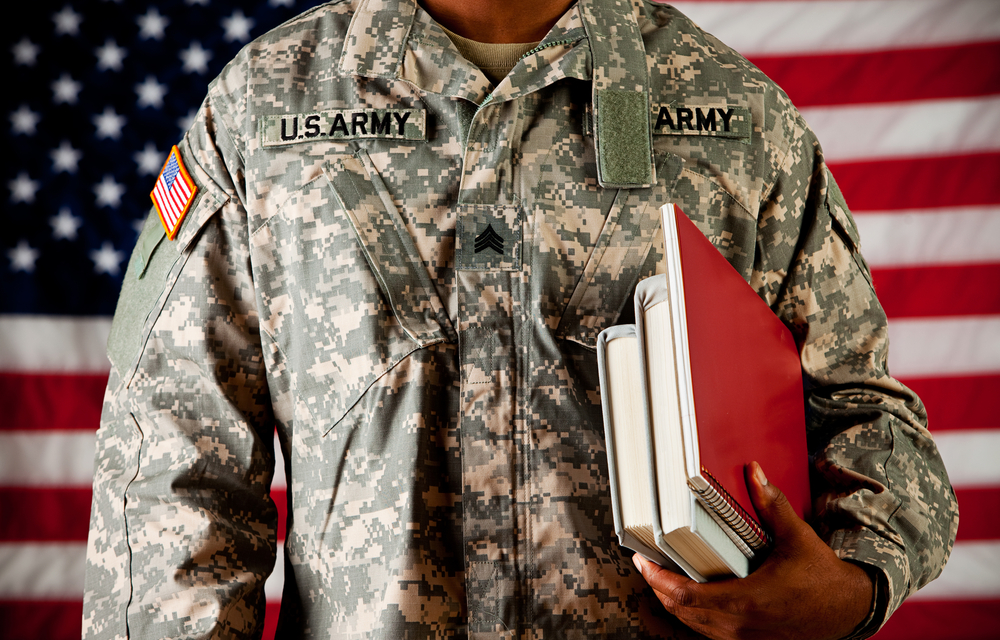
Cheryl Casey / Shutterstock.com
Understanding the educational benefits that are available to current and past members of the military and their dependents is tricky. There are all sorts of programs, some only open to certain branches, that provide educational incentives, grants, scholarships, and loan repayment. If you’re interested in a brief overview of the many benefits that are available to all branches of the military, explore this visual guide. This blog post will explore only the GI Bill in detail.
History of the GI Bill
The original GI Bill was signed into law in 1944 and ended in 1956. It was intended to benefit soldiers who returned home after World War II by providing unemployment pay, education, and loans to veterans who would otherwise not be able to afford school and homes. During its original run, the GI Bill helped nearly 50% of WWII veterans attain postsecondary education and 15% obtain home loans. Few veterans took advantage of unemployment assistance.
Since 1956, the GI Bill has experienced two more changes. The Post 9/11 GI Bill is the most recent addition (2008), and the GI Bill was reinstated in 1986 as the Montgomery GI Bill. The Montgomery GI Bill has mainly the same goals as the original GI Bill: education and home loans for veterans. The Post 9/11 Bill elaborates on this, giving soldiers who served on active duty for at least 90 days after the events of September 11, 2001 more educational benefits, living allowances, and the ability to pass unused educational benefits on to their dependents (spouses or children).

Songquan Deng / Shutterstock.com
Members of the military now must choose between the benefits offered by the Montgomery GI Bill and the Post 9/11 GI Bill. If a service member decides to switch from the Montgomery to the Post 9/11 GI Bill, he or she can. However, once the switch has been made it cannot be undone.
Differences between the Montgomery and Post 9/11 GI Bills
| Post 9/11 | Montgomery-Active Duty | Montgomery-Special Reserves | |
| Who qualifies? | Members of the military who served at least 90 days on active duty after September 11, 2001 OR members who served at least 30 days after September 11, 2001 and were honorably discharged due to a disability | Members of the military who served at least two years on active duty | Members of Reserve or National Guard units who agree to serve at least six years from the time they elect to receive GI Bill benefits |
| How long can the award be used? | 36 months of benefits available for 15 years after honorable discharge from the military | 36 months of benefits available for 10 years after honorable discharge from the military | 36 months of benefits available for 14 years while serving with a Reserves or guard unit; benefits end when individual is no longer serving |
| Besides the member of the military, who else can use GI Bill benefits? |
|
No one | No one |
| Do you have to pay to use benefits? | No, but the amount of money awarded will be based on time served. | Yes, service members must pay $100/month for 12 months. | Yes, service members must pay $100/month for 12 months. |
| How is the award calculated? | The award depends on the type of education, enrollment, and location. For a look at the 2016/17 maximum awards, click here. | The award depends on the length of enlistment, type of education, and enrollment. For a look at the most recent awards, click here. | The award depends on the type of education and enrollment. For a look at the most recent awards, click here. |
| What is the maximum award? | Maximum covered for a college degree is all tuition and fees at a public institution or $21,970.46 annually at a private institution | Maximum monthly award of $1,789.00 | Maximum monthly repayment of $368.00 |
The Montgomery GI Bill is not necessarily better or worse than the Post 9/11 GI Bill; it’s just not as new. Progress is made over time (in government, progress can be slow), and there is a huge difference between 1986 (when the Montgomery GI Bill was signed) and 2008 (when the Post 9/11 GI Bill was signed). The Post 9/11 GI Bill includes a relocation payment if the service member is moving to attend school, a housing allowance, a stipend for books and supplies, and tuition. The Montgomery GI Bill focuses mainly on tuition reimbursement, and the maximum amount for an active duty soldier is slightly lower than that offered by the Post 9/11 GI Bill.

Sean Locke Photography / Shutterstock.com
Benefits Explained
So what exactly can all this money be applied toward? Pretty much anything that involves education is fair game. Awards from the Montgomery GI Bill can be applied to postsecondary institutions (both degree and certificate programs), apprenticeships, on-the-job training, correspondence courses, flight training, and co-ops. The Post 9/11 GI Bill covers all of the same programs as the Montgomery GI Bill, as well as tuition for non-degree-granting programs and testing, licensing, and certification test fees. The Post 9/11 GI Bill also provides a housing allowance (for those not on active duty), up to $1,000 for books and supplies, and a $500 stipend for relocation for school. Benefits from both programs may also be applied toward private tutoring or precollege admission coursework.
The Yellow Ribbon Program is a part of the Post 9/11 GI Bill that provides additional money for postsecondary education. The way it works is this: Degree-granting schools can elect to set aside a specific amount of money for students who will be funding education through the GI Bill. This amount is matched by the Department of Veterans Affairs and given to service members and their children (if benefits were transferred) if the GI Bill does not cover the entire cost of attendance at the institution. Here’s the catch: The service member must be fully eligible for the Post 9/11 GI Bill (having served at least 36 months on active duty or 30 days before being discharged due to a disability). Here you can find information about the schools participating in the Yellow Ribbon Program as of the 2015/16 school year.
Transferring Benefits to Dependents
One of the main changes between the Montgomery and Post 9/11 GI Bills is that the Post 9/11 GI Bill allows benefits to be handed over to spouses and children. It’s important to realize that if a service member makes this choice, it must be processed while he or she is still serving. The service member isn’t required to pass down all 36 months of benefits but can instead choose however many he or she wants (each month is the equivalent of one month of full-time education).
There is a cost to transferring benefits, however. The service member must already have served six years and agree to serve four more OR have already served at least 10 years and agree to serve four more or the maximum allowed by the enlistment policy OR have served for 20 years or be eligible for retirement (depending on how close retirement is, the service member may have to serve one to three more years).

michaeljung / Shutterstock.com
This may seem like quite the commitment for a service member to make in order to further the education of a family member, but depending on timing, the commitment may not be that long. If a service member elects to transfer benefits as soon as he or she hits the six-year mark, his or her commitment to the military may be finished before age 30. And remember, Post 9/11 GI Bill benefits are available to both the service member and his or her spouse for 15 years after the service member leaves active duty. Children can use GI Bill benefits from high school graduation until they turn 26 years old.
What next?
Service members can apply for their GI Bill benefits at their local Veterans Affairs office, online, or by calling 1-888-442-4551 to receive a paper application. Talking to the financial aid office at your institution is also a good idea. The financial aid officer may have forms relevant to military personnel (or those receiving military benefits) and can help answer any questions you may have. If you are a service member still on active duty and are hoping to use benefits at the same time, you will also need to talk to your unit and your duty station’s education office.
-
Creative Ways to Save Money Even When You Feel Broke
-
How to Afford College When the FAFSA Doesn’t Foot the Bill
-
Study Finds That Children Get More Expensive as They Get Older
-
Managing Finances: What’s Efficient and What’s Not
-
Scholarships for Students from Ohio
-
Scholarships for African Americans and Students of African Heritage
-
Scholarships for Students from Kentucky
-
Five Dos and Don’ts of Managing Student Loans as a New Doctor
-
Scholarship Opportunities for Undocumented Students
-
Scholarships for Students from New Jersey
-
Scholarships for Students from Florida
-
Scholarships for Students from Washington

